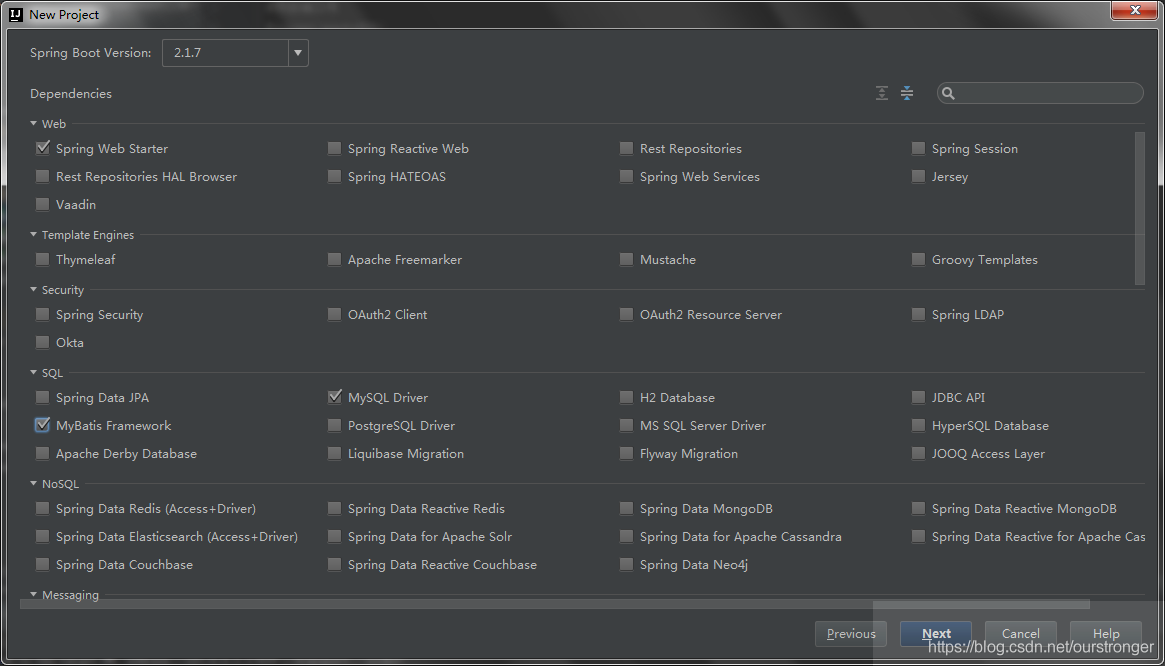1、工程创建
创建一个基本的Spring Boot工程,添加Web依赖,MyBatis依赖以及MySQL驱动依赖,如下图:

创建成功后,添加Druid依赖,并且锁定MySQL驱动版本,完整的依赖如下:
<dependencies>
<dependency>
<groupId>org.springframework.boot</groupId>
<artifactId>spring-boot-starter-web</artifactId>
</dependency>
<dependency>
<groupId>org.mybatis.spring.boot</groupId>
<artifactId>mybatis-spring-boot-starter</artifactId>
<version>2.1.0</version>
</dependency>
<dependency>
<groupId>com.alibaba</groupId>
<artifactId>druid-spring-boot-starter</artifactId>
<version>1.1.10</version>
</dependency>
<dependency>
<groupId>mysql</groupId>
<artifactId>mysql-connector-java</artifactId>
<scope>runtime</scope>
<version>5.1.27</version>
</dependency>
<dependency>
<groupId>org.springframework.boot</groupId>
<artifactId>spring-boot-starter-test</artifactId>
<scope>test</scope>
</dependency>
</dependencies>
|
2、多数据源配置
这里首先在application.properties中配置数据库基本信息,然后提供两个DataSource即可,直接上代码。
application.properties中的配置:
spring.datasource.one.url=jdbc:mysql:///test01?useUnicode=true&characterEncoding=utf-8
spring.datasource.one.username=root
spring.datasource.one.password=root
spring.datasource.one.type=com.alibaba.druid.pool.DruidDataSource
spring.datasource.two.url=jdbc:mysql:///test02?useUnicode=true&characterEncoding=utf-8
spring.datasource.two.username=root
spring.datasource.two.password=root
spring.datasource.two.type=com.alibaba.druid.pool.DruidDataSource
|
再提供两个DataSource配置,如下:
@Configuration
public class DataSourceConfig {
@Bean
@ConfigurationProperties(prefix = "spring.datasource.one")
DataSource dsOne() {
return DruidDataSourceBuilder.create().build();
}
@Bean
@ConfigurationProperties(prefix = "spring.datasource.two")
DataSource dsTwo() {
return DruidDataSourceBuilder.create().build();
}
}
|
3、MyBatis配置
MyBatis的配置,不同于JdbcTemplate,MyBatis的配置要稍微麻烦一些,因为要提供两个Bean,因此这里两个数据源我将在两个类中分开来配置,首先来看第一个数据源的配置:
@Configuration
@MapperScan(basePackages = "org.sang.mybatis.mapper1",sqlSessionFactoryRef = "sqlSessionFactory1",sqlSessionTemplateRef = "sqlSessionTemplate1")
public class MyBatisConfigOne {
@Resource(name = "dsOne")
DataSource dsOne;
@Bean
SqlSessionFactory sqlSessionFactory1() {
SqlSessionFactory sessionFactory = null;
try {
SqlSessionFactoryBean bean = new SqlSessionFactoryBean();
bean.setDataSource(dsOne);
sessionFactory = bean.getObject();
} catch (Exception e) {
e.printStackTrace();
}
return sessionFactory;
}
@Bean
SqlSessionTemplate sqlSessionTemplate1() {
return new SqlSessionTemplate(sqlSessionFactory1());
}
}
|
MyBatisConfigOne类,首先指明该类是一个配置类,配置类中要扫描的包是org.sang.mybatis.mapper1,即该包下的Mapper接口将操作dsOne中的数据,对应的SqlSessionFactory和SqlSessionTemplate分别是sqlSessionFactory1和sqlSessionTemplate1,在MyBatisConfigOne内部,分别提供SqlSessionFactory和SqlSessionTemplate即可,SqlSessionFactory根据dsOne创建,然后再根据创建好的SqlSessionFactory创建一个SqlSessionTemplate。
这里配置完成后,依据这个配置,再来配置第二个数据源即可:
@Configuration
@MapperScan(basePackages = "org.sang.mybatis.mapper2",sqlSessionFactoryRef = "sqlSessionFactory2",sqlSessionTemplateRef = "sqlSessionTemplate2")
public class MyBatisConfigTwo {
@Resource(name = "dsTwo")
DataSource dsTwo;
@Bean
SqlSessionFactory sqlSessionFactory2() {
SqlSessionFactory sessionFactory = null;
try {
SqlSessionFactoryBean bean = new SqlSessionFactoryBean();
bean.setDataSource(dsTwo);
sessionFactory = bean.getObject();
} catch (Exception e) {
e.printStackTrace();
}
return sessionFactory;
}
@Bean
SqlSessionTemplate sqlSessionTemplate2() {
return new SqlSessionTemplate(sqlSessionFactory2());
}
}
|
4、mapper创建
mapper1:
public interface UserMapperOne {
List<User> getAllUser();
}
|
对应的XML文件:
<?xml version="1.0" encoding="UTF-8" ?>
<!DOCTYPE mapper
PUBLIC "-//mybatis.org//DTD Mapper 3.0//EN"
"http://mybatis.org/dtd/mybatis-3-mapper.dtd">
<mapper namespace="org.sang.mybatis.mapper1.UserMapperOne">
<select id="getAllUser" resultType="org.sang.mybatis.model.User">
select * from t_user;
</select>
</mapper>
|
mapper2:
public interface UserMapper {
List<User> getAllUser();
}
|
对应的XML文件:
<?xml version="1.0" encoding="UTF-8" ?>
<!DOCTYPE mapper
PUBLIC "-//mybatis.org//DTD Mapper 3.0//EN"
"http://mybatis.org/dtd/mybatis-3-mapper.dtd">
<mapper namespace="org.sang.mybatis.mapper2.UserMapper">
<select id="getAllUser" resultType="org.sang.mybatis.model.User">
select * from t_user;
</select>
</mapper>
|
最后单元测试,运行测试类:
@Autowired
UserMapperOne UserMapperOne;
@Autowired
UserMapper userMapper;
@Test
public void contextLoads() {
List<User> allUser = UserMapperOne.getAllUser();
System.out.println(allUser);
List<User> allUser2 = userMapper.getAllUser();
System.out.println(allUser2);
}
|


